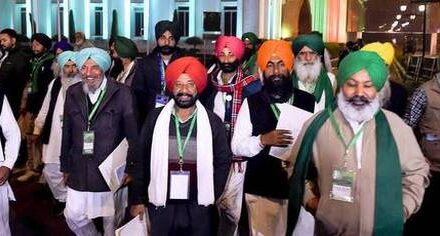Afsar Jafri*
The recent escalation in food prices is the latest calamity to hit the poor and marginalised communities in India. The price of food and other essentials has been rising for the last 12 weeks and the current inflation level is the highest witnessed since November 2004. Retail prices of some essential food commodities have seen a sharp increase. Retail prices of gram, sugar, mustard oil, vanaspati and onions have increased by up to 11 per cent in the national capital in last one month, pushing inflation to a 39-month high of seven per cent. (1)
“SHINING INDIA” AT THE COST OF “SUFFERING INDIA”
Facing public outrage on rising food prices, the United Progressive Alliance (UPA) government, took refuge by issuing statements that inflation is a global phenomenon. Even though it is a global phenomenon and food riots have been witnessed in more than 30 countries, the food crisis in India is primarily caused by the pro-market biased policies of the government. Indians (along with the Chinese) have been accused of eating more due to rising prosperity resulting in the global food shortages. But the per capita food consumption and calorie intake indicates that irrespective of the current inflationary trend, majority in India are facing hunger and starvation since liberalisation policies were introduced.
The irony is that though signs of the food and agriculture crisis were evident, policy makers continued with neoliberal policies to benefit corporations. The government is witness to the increasing schism between ‘shining India’ and ‘suffering India’ but their mantra has always been that only the pro-capitalist, corporation driven economy can bring sustained economic growth which will trickle down to benefit the disadvantaged sections of the population. Despite looming inflation, the Economic Advisory Council to the Prime Minister of India believes that robust investment growth and strong corporate performance would drive India towards prosperity. It also says that “in the current year, the strong growth in agricultural GDP has come mostly from activity other than food grain production, namely commercial crops, horticulture and animal husbandry.” (2)
This paradigm shift in foodgrain production was introduced under the World Bank direction which “required India to move away from the existing subsidy-based regime and instead, invest in building a solid foundation for a highly productive, globally competitive and diversified farm sector.” (3). The report recommended the removal of subsidies related to grain procurement and Public Distribution System (PDS), diversification of Indian agricultural development, increased space for the private sector in agriculture extension services, contract farming and for agro-industry in general. Interestingly during the recent crisis the Indian government severely criticised the World Bank for their advice to countries to shift from food crops for domestic population to cash crops for exports. (4) Addressing a special meeting of the United Nations Economic and Social Council to consider the issue of rising food prices, India’s UN Ambassador Nirupama Sen, said that the “tradition of these institutions’ advice was partly responsible for the crisis in the first place”.
The corporate led growth regime has contributed to mass displacement of mainly small and marginal farmers, leading to loss of livelihood opportunities and employment generation for the common people. The widespread farmers’ suicides, which reached 150,000 (5) in just eight years (1997-2005), is a manifestation of the ongoing corporatisation and mindless deregulation of the agricultural sector. Though India is seen as a rising economic power and it is hoped that a trickle down effect will benefit the poor and marginalized, in reality the gap between ‘Shining India’ and ‘Suffering India’ is widening: 77 percent (6) of the Indian population who survive on Rs. 20/- (half a US dollar) a day, does not figure in this ‘booming Indian economy’.
MYTH OF GLOBAL MARKET INTEGRATION
Two years of wheat imports have exposed the fallacies of neoliberal policies. India, once a wheat exporting country was forced to become the largest wheat importer through a design to benefit the global food corporations. The declining procurement of locally produced wheat by the Food Corporation of India (FCI) prepared the ground for wheat imports. This was a sea change from the situation during 2001-2002 to 2004-2005, when the country exported 12.4 million tonnes of wheat. Since early 2006, the USA was pressuring India to break its tariff wall and open up for wheat imports. In March, despite predictions of a bumper wheat harvest, the US Wheat Associates (7) said India would import up to 30 lakh tonnes of wheat in that year. (lakh = 100,000). Following this, the government reduced the applied tariff on wheat from 60 per cent to zero for imports by the State Trading Corporation of India (STC) while for private traders, the duty was brought down to five per cent. This led to import of 5.5 million tonne of wheat in 2006 at prices ranging in between US $178.75 to US $228.94 (8) a tonne when the local wheat production was 69 million tonnes. In 2007 the government first scrapped a wheat import tender at an average price of $263 per tonne in June citing high prices but in July, less than 40 days later, it contracted 5.11 lakh tonne of wheat at an average price of $325.59 per tonne. Then again on September 3, it contracted 7.95 lakh tonne of wheat at an average price of $389.45 (9) but only 1.8 million tonnes of wheat finally landed on Indian ports at double the price of last year despite increase in wheat production upto 74.82 million tonnes in that year. Thus the government paid foreign traders exorbitant price upto Rs 16,000 per tonne while the MSP (market spot price) was only Rs. 8500 per tonne. And the main beneficiaries of the India’s wheat import were giant grain corporation like Glencore, Toepfer, Cargill and the Australian Wheat Board who gained at the cost of Indian farmers. However, the import of wheat at expensive rates led to the sharp increase in local wheat and wheat flour prices making it unaffordable for the poor.
The story of wheat is not different from what happened in late 1990s in the edible oil sector when under pressure from the USA, India reduced the duty on the crude edible oil to 15 per cent in August 1998. In July 1999 Oil World reported that India was set to replace China as the world’s largest vegetable oil importer and projected India’s import around 3.6 million tonnes (MT) in 1998-99 oil year. In the first nine months India had imported 3 MT oil and during 1998-99 oil year, edible oil import amounted to a massive 4.4 MT, an increase of 111 per cent over the previous year’s 2.08 MT. The increasing reliance on imports considerably weakened the domestic edible oil production.
In spite of the above experiences, early this year the government allowed liberalisation of imports to deal with rising inflation by reducing import duty to zero in respect of articles like pulses, edible oil and maize; withdrawal of four per cent additional duty on edible commodities; reducing import duty on refined oil and vegetable oil by 7.5 per cent; reduction of import duty on butter and ghee to 30 per cent. But does the reduction in import duties and import of food grain help in containing the domestic food prices? In June 2006 the same government had unilaterally liberalised imports to bolster the supply side of essential commodities but this couldn’t control inflation. The government’s Economic Survey 2006-07 had said that “duty free wheat imports did not help to check price rise, rather the rising global prices impacted the domestic market in a subtle way”. A billion plus population of India cannot depend on the ‘ship-to-mouth’ existence and the government needs to restore its policy to build up food grain reserves in order to serve the farmers and the consumers. Moreover there is greater threat that the unilateral trade liberalisation as a solution to inflation would soften India’s position in WTO.
PUBLIC DISTRIBUTION UNDERMINED BY CORPORATIONS
The Public Distribution System (PDS) (10) has been one of the most crucial elements of food policy and food security system in the country. But the Indian government has been deliberately weakening the public distribution system under the World Bank pressure to benefit the agribusiness corporations. India witnessed a shortage of wheat in 2005-2007 because systematically the foodgrain (wheat and rice) buffer stocks were lowered through below target offtake of grains by government from the farmers.
In order to make a case for wheat import under US pressure, the government went slow on the procurement of wheat in 2005-2007 and deliberately kept the government’s purchasing price low to allow multinational corporations to enter the trade. In 2006, Cargill India, the Australian Wheat Board, and two Indian based companies with a lot of foreign equity, ITC and Adani Export, procured 30 lakh tonnes of wheat. In 2003-04, government procured 16.8 million tones of wheat which went down to 14.8 million tonnes in 2004-05 and it further reduced to 11.1 million tonnes in 2005-2006 and last year it was just 9.2 million tonnes. (11) The government deliberately created a situation of food insecurity in the country by allowing multinational corporations to move into agro-business and large procurement. However in 2008 it corrected its faulty policy of reduced procurement and procured a record 20.5 million tonnes (12) till 20 May this year, which is a huge jump from a meagre 11.1 million tonnes in the entire season last year, helped by a bumper crop and higher prices. Moreover the government went a step further and Indian Railways decided to stop allocating wagons for transporting wheat from the growing areas by the private trader, impacting their wheat procurement.
The reduced procurement of food grains resulted in reduced amount of off take by the state governments for the subsidized grain distribution through a network of more than 450,000 Fair Price Shops (FPS). An analysis of data from 2005-06 onward reflects a consistent fall in allocation of wheat in the BPL (below the poverty line) category, even while there was a perceptible upward shift in demand. (13) It means that at a time when open market prices of wheat were rising, there wasn’t enough wheat in the PDS for those eligible to buy it there for less than the market prices.
COMMODITY FUTURE: TRADING ON HUNGER
Besides the agribusiness, the traders engaged in future trading in commodities were beneficiaries of the declining food procurement and shrinking of buffer stocks. Infact the opposition parties in India claimed that the lowering of procurement and shrinking of buffer stocks was meant to facilitate the speculative trading of foodgrains. Reduction in government stocks is imperative for the private traders and speculators to speculate on prices of foodgrains. Mr. Sitaram Yechury representing the Community Party of India (Marxist), debating the issue of price rise in the Parliament said that, “three billion dollars a day is the speculation that is taking place in the commodity exchange market of futures and forward trading” across three national level electronic exchanges and twenty-one regional exchanges. In just two weeks, from 17 March to 31 March 2008, the total value of trading at these commodity exchanges was Rs. 2,12,465.17 crores (14). The cumulative value of trade in the last financial year, from 1 April 2007 to 31 March 2008 was to the tune of Rs. 40,65,989 crores as compared to Rs. 5,71,759 two years ago in 2004-2005. One firm calculates that the amount of speculative money in commodities futures markets, where investors do not buy or sell a physical commodity, like rice or wheat, but merely bet on price movements – has ballooned from US$5 billion in 2000 to US$175 billion to 2007 (15). The price behaviour of food over 2007 and the first three months of 2008 is more or less explained by such speculation on food products.
But the speculation and bidding in food stocks does not benefit small and marginal farmers. The Economic Survey 2007-08 clearly stated that, “Direct participation of farmers in the commodity futures market is somewhat difficult at this stage as the large lot size, daily margining and high membership fees … work as a deterrent to farmers’ participation in these Markets. Farmers can directly benefit from the futures market if institutions are allowed to act as aggregators on behalf of the farmers”. Though the government has put a ban on future trading of some crops, it may be opened up anytime, therefore the government must totally ban the futures trading of food commodities as demanded by the citizens groups and left parties.
RETREATING FROM CAPITALIST ECONOMY
The UPA government under the leadership of Manmohan Singh seems to concede the failure of the capitalist system (but it could be a gimmick for the election, which is due in early 2009). The inflation also made him realise the viability of the small farm essential for the survival of millions of small and marginal farmers and to deal with the food crisis. Recently the Prime Minister made a statement which is discordant with the general pro-market reforms push, including promotion of contract farming, that the UPA government has encouraged for the past four years. At the Global Agro-Industries Forum, the Prime Minister said that, “collectivization, corporatization and land consolidation through land alienation are neither possible nor socially desirable, while warning that rising food prices could hamper the country’s economic growth…We cannot wish away the existence of economically unviable farms… It is particularly worrisome that the new economics of biofuels is encouraging a shift of land away from food crops”. (16) Even two of his colleagues from the cabinet showed their concern on the capitalist economic model when Mr. Kamal Nath (Union Commerce Minister) and Mr. Sharad Pawar (Union Agriculture Minister), stated that if the need arose they were ready to look at invoking the Nehru-era controls built within existing commodity regulation laws. The last few months have witnessed several steps where the UPA government have retreated from its capitalist move and brought in government regulation to check inflation. One can infer from this development that the UPA government headed by Manmohan Singh (a former World Bank governor) has lost the confidence in the neo-liberal trajectory in agricultural reforms.
SMALL-SCALE FARMERS HOLD THE KEY
Given the deepening of agrarian crisis which is causing hunger and malnutrition in rural areas due to unprecedented decline in purchasing power in the rural areas, the first priority of the government should be to strengthen the agriculture sector by increasing public investment, facilitating public control over inputs and market, strictly regulating the corporate investment in agriculture as well as retreating from neoliberal reforms in agriculture.
Since India is a land of small and marginal farmers, and over 650 million of its over one billion population are directly or indirectly dependent on agriculture, there is urgent need to encourage and strengthen biodiversity based small scale agriculture which are crucial for the food security of the millions of Indians. Infact, it is the small biodiverse farm, which has higher productivity than large industrial farms. Large farmers and industrial farming has serious limitations on increasing agricultural productivity. In the face of a worsening worldwide food-price crisis, even the President of the International Fund for Agricultural Development (IFAD), Mr. Lennart Båge feel that small farmers are now essential to ensure food security, spur economic growth and help mitigate climate change. He said that smallholder farmers are a vital global asset, a key factor for increased food production, economic growth and development, and mitigating climate change. The 2 billion people in rural areas in the developing world can be tremendously more productive. They can be part of the supply response, feeding the world, and also very much a part of the climate change agenda, both in terms of adaptation and mitigation. (17)
In India, small farm based on internal inputs are the only hope to deal with the impending food crisis and can ensure food security and food sovereignty to millions of people living off the farm. A food secure and peaceful India is in the hands of her small farmers.
* Afsar Jafri is a senior associate with Focus on the Global South
NOTES
1. Retail prices shoot up in Delhi, The Financial Express; April 04, 2008; http://www.financialexpress.com/news/Retail-prices-shoot-up-in-Delhi/292538/#
2. Review of the Economy 2007-08, Prime Minister’s office
3. World Bank for radical farm policy changes, The Hindu Business Line, December 20th, 2004; http://www.thehindubusinessline.com/2004/12/20/stories/2004122000690200.htm
4. India blames World Bank, IMF for food, fuel crisis, May 22, 2008; http://www.livemint.com/2008/05/22115241/India-blames-World-Bank-IMF-f.html
5. Farm suicides rising, most intense in 4 States by P. Sainath; The Hindu, November 12 2007; http://www.thehindu.com/2007/11/12/stories/2007111253911100.htm
6. Arjun Sengupta’s (National Commission for Enterprises in the Unorganised Sector) Report said that 77 percent of the Indian population or 836 million people survive on a per capita daily consumption of up to Rs. 20 (in 2004-05). http://nceus.gov.in/Condition_of_workers_sep_2007.pdf
7. A US trade body funded by the federal government and US wheat producers
8. CVC squeezes Govt on wheat imports by Ashok B Sharma; Financial Express, September 30 2007; http://www.financialexpress.com/news/CVC-squeezes-Govt-on-wheat-imports/222855/
9. Delay in decision on wheat buy costs govt dear, again by Varun Jaitly; Financial Express; September 10, 2007; http://www.financialexpress.com/news/Delay-in-decision-on-wheat-buy-costs-govt-dear-again/215588/#
10. PDS is a rationing mechanism, entitles households to essential commodities such as rice, wheat, sugar, kerosene and edible oil at subsidized rates. The responsibility of operating them is shared by Central and State governments.
11. Debate on price rise in the Rajya Sabha, the Parliament of India, 16th April 2008
12. Wheat purchases to double in 2008, The Economic Times, May 22, 2008; http://www1.economictimes.indiatimes.com/News/Economy/Agriculture/Wheat_purchases_to_double_in_2008/articleshow/3063332.cms
13. ibid.
14. One crore = 10million
15. Making a killing from hunger: We need to overturn food policy, now! GRAIN, April 2008
16. Corporate farming won’t help: PM, Times of India, April 11, 2008; http://timesofindia.indiatimes.com/India/Corporate_farming_wont_help_PM/articleshow/2942627.cms
17. IFAD head on food crisis by Tim Nater, May 07, 2008; http://www.donorplatform.org/content/view/190/157/1/0/









